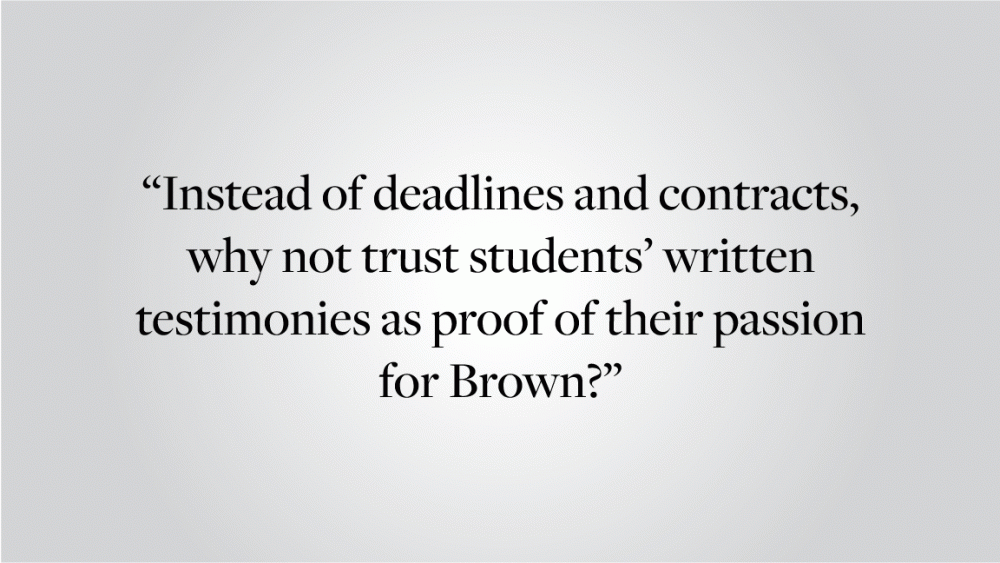As we move further into fall, many people look forward to apple orchards, hayrides and Halloween. But for high school seniors around the world, it’s the day after Oct. 31 that they have circled on their calendars. On Nov. 1, scores of hopeful Brunonians will submit their Early Decision applications. An ED application is marketed as a way for passionate applicants to show the Admission Office just how interested they are in the University ― interested enough that, if accepted, they are contractually obligated to enroll.
On its surface, the ED option seems like a harmless way to select a class of students with intense school spirit. However, looking more closely at the details, it becomes apparent that the ED application option is yet another aspect of the college admissions process that disadvantages those from lower-income backgrounds.
By applying ED and confirming that they will enroll if accepted, students usually get stuck with whatever financial aid they are offered. To its credit, the University meets 100 percent of demonstrated financial need.
The issue is that it is extremely difficult for applicants to foresee how much they will actually have to pay before they are accepted. Brown determines each student’s Estimated Family Contribution using the Free Application for Federal Student Aid and the College Scholarship Service, two forms of measuring a student’s financial means. These means of calculation are both very dense and time-consuming to complete, not to mention difficult to understand. For families with less financial literacy, it can be challenging to understand what the calculations from these forms mean. While there are resources like Net Price Calculators, a tool that provides families with a mock calculation of their EFC, these tools are only ballpark estimates. In short, by applying to the University ED, students are effectively agreeing to contribute as much as the University deems appropriate.
The University does claim that if an ED admit can prove that it didn’t meet 100 percent of their demonstrated need and make a compelling case that they cannot afford tuition, they can occasionally wiggle out of their contract. However, the University is the ultimate arbiter of this decision. Putting the burden on students to prove their inability to pay once again complicates the college application process for people less financially well-off. Plus, there is no guarantee their appeal will be approved. This might deter certain applicants from even applying ED in the first place.
Because applying ED comes with numerous financial barriers, it is no surprise that students whose families make over $250,000 annually are two times more likely to apply ED than students whose families make under $50,000.
So, the wealthy can more comfortably apply ED. Why does that matter? In the University’s case, it’s because ED applicants are about three times as likely to get in, as compared to Regular Decision applicants. The ED option, among other aspects of college admissions that favor the wealthy, may be part of the reason why 72 percent of students at the most selective colleges come from families in the top quartile of income. Students from families in the lowest quartile make up only 3 percent of students at these schools. Some may claim the higher acceptance rate for ED applicants is due to the higher proportion of qualified students in the ED pool or the higher percentage of recruited athletes who, through a slightly modified process, apply ED. While this may be true, it might not fully account for the large difference in ED and Regular Decision acceptance rates.
The University claims that the applicants who apply ED are those who are the most dedicated to the school. But a wealthy student who applies ED is not proving themselves any more passionate about going to the University than someone who, due to their financial situation, can’t afford to forgo comparing financial aid offers. While the University will likely offer the same financial aid package following the ED process as it would to that same student following an RD application, other schools’ aid packages can help students bargain down Brown’s financial aid office. For the University to equate passion with a willingness to give up financial autonomy is classist. It suggests that an applicant’s desire to consider the full financial ramifications of their decisions is actually just a sign that they “don't want it enough.”
The good news is there are numerous alternatives that still allow students to convey preference and interest without requiring tens of thousands of dollars to back it up. After realizing the unfairness of the ED option, Harvard and Princeton both replaced it with a Restrictive Early Action program. Students can apply to only one school REA, allowing them to demonstrate their interest, but are not contractually obligated to enroll if admitted. A second option would be to have more faith in the application process. Brown requires supplemental essays as part of its application for a reason. They are specific to the University and can be used to gauge how interested a student is. Instead of deadlines and contracts, why not trust students’ written testimonies as proof of their passion for Brown?
Inclusion, diversity and progressivism are central parts of the University’s identity. By abolishing the ED application option, Brown would be showing its commitment to those values, giving students from all economic backgrounds a fairer shot at their top school.
Jordan De Padova ’24 can be reached at jordan_de_padova@brown.edu. Please send responses to this opinion to letters@browndailyherald.com and op-eds to opinions@browndailyherald.com.

ADVERTISEMENT




